[kl-bogel] Melawat Mesir Bumi Ambia 'nan bersih'.. 1
http://www.youtube.com/watch?v=aITsbw3Xbwo


It is said that the city - a single organism.
Home with them, dwelling in his people-living cells. Electricity, water, sewerage - that without which would not exist these cells. Gardens and parks - the lungs of the city, the center is its heart. Roads, arteries of the city - supply and saturate his organs - quarters of the necessary materials.
The life of this living organism does not disappear for a second and during his life he had to get rid of toxins - litter and waste.
If we continue this analogy, the city scavengers, so call this a quarter of Cairo - the liver of old and sick body, which passes over the age of ten centuries.
Getting here is easy. In just half an hour you can reach the Citadel of Saladin, one of the most visited tourist sites in Cairo.
Already from the Citadel you make out on the immense panorama of the ten millionth metropolitan district with houses unusual red-violet color.
Another question - is it worth to go here at all and are you ready for what is here will see.
I decided on this, prompted by curiosity and passion for the photographer, although perfectly aware that coming here alone and at night can be dangerous. Reassured that at the end of a long journey to Egypt, my view has been far from the kind of glossy tourist with an expensive camera and I to some extent mimic the surrounding environment me.
I knew that somewhere out there in the mountains Mokattam, the Monastery of St. Simeon and the road to it just passes through the city scavengers, so after some deliberation, decided to visit those places.
Only appeared on the outskirts of the quarter, I saw this picture: teenagers gathered sounds from a tape recorder music, dancers, relieving each other out in the center of the circle and incendiaryrap dancing oriental dance.
http://www.youtube.com/watch?v=aITsbw3Xbwo
According to statistics from Cairo generates 6500 tonnes of waste per day, of which 3-3.5 thousand tons harvested zaballiny so called representatives of particular social group of about 40 thousand people living in the Medina district Zebela. For many years the only thing they are doing, handed down from generation to generation - collecting, sorting and recycling waste.
The area came in 1969 when the city administration decided to Cairo, all the garbage collectors to concentrate in one place.


Rubbish dump here brought huge that I saw standing on the road - there were about fifty, no less!
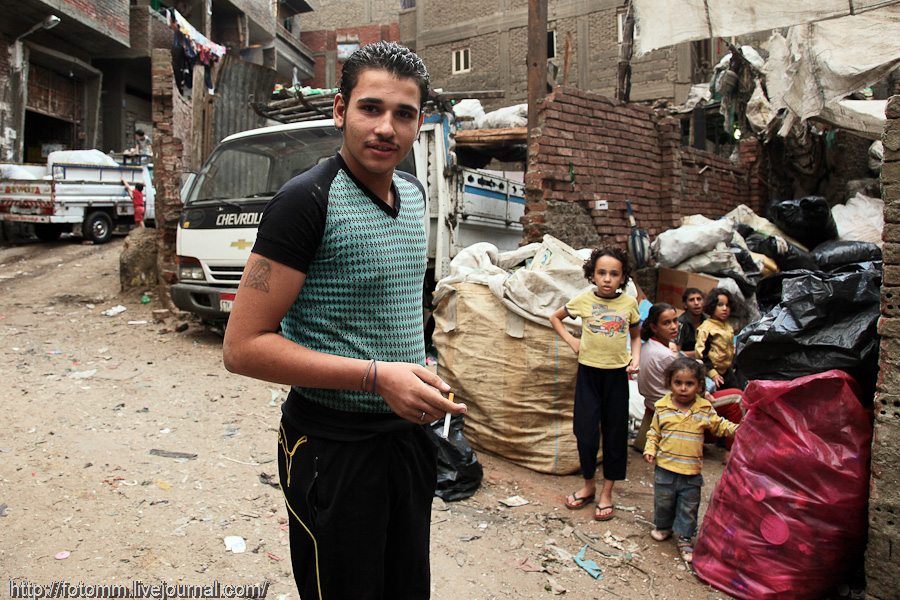

Hanging from the balconies and roofs of piles of rubbish, bags of waste, blocking the already tight streets - this is the first thing that catches the eye when you get on this gloomy territory quarter.

Metal, paper and cardboard, rags and plastic - all packed into individual bags. What you then just burn, from which over the quarter is heavy with the smell of burning plastic, then taken away for recycling facilities.


Meanwhile on the streets is normal life. Children play and make noise, the men sitting primly and smoke hookah, immediately selling fruit and baked bread, on the first floor houses the usual food stalls and edalni. Apart from the people on the streets full of animals - goats and chickens that dogs, cats, as well as pigs, which also contribute their mite to the destruction of all possible waste.

A couple times I tried to look inside the homes, but the lower floors are generally so swamped with dense, break up that I could not.
Before you "dive" inside, I gained a deep breath, that even outside breathed with difficulty, not to mention the stench that prevails inside ..
The dim setting sun made its way through the barely small windows without glass and doorways without doors. In the darkness with hardly could be seen swarming among the waste of human figures. Some at the sight of the camera made prohibiting gestures, others continued to busily engaged in the business, not paying any attention to me.
Within a minute, I would jump out, so as not to suffocate ..



And nobody pays any attention to the huge bales That in some places already cover travel, hanging with all the balconies are on rooftops and in courtyards.
Add to this myriad of buzzing flies, dead rats and cats under their feet, and most importantly smell that accompanies all this, has developed a very real picture of the apocalypse.








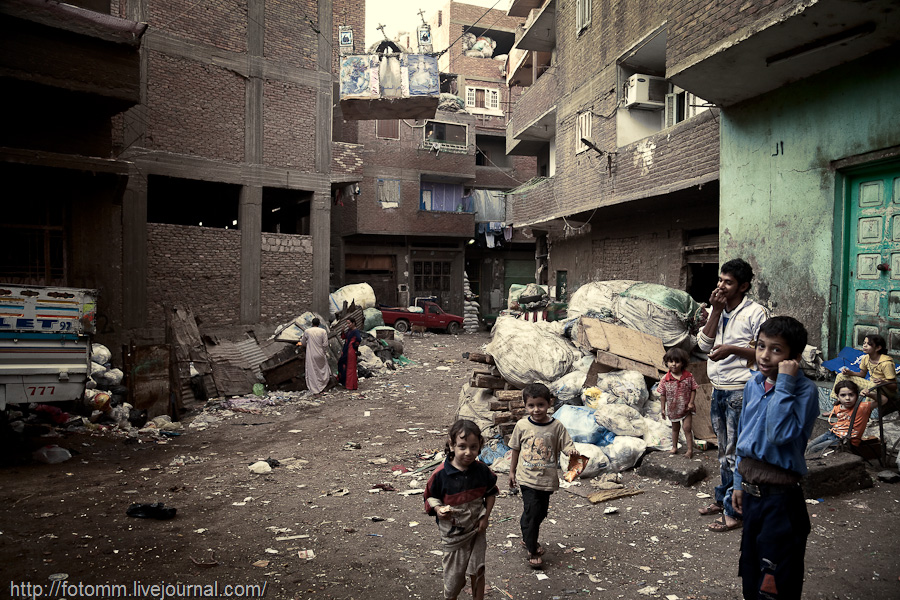
Wandering the streets, littered with garbage, I think often come across images of Jesus, crosses, and other attributes of the Christian faith.
The main population of the quarter - the Copts, adherents of one of the branches of the Christian Church. Copts have become scavengers in the days of Caliph Al-Hakim. It was the ruler of the Fatimid dynasty, conquered Egypt. He ended a relatively peaceful life of all Christians, and Muslims living in the country. Copts in particular have lost everything. They were supposed to do the dirtiest and hard work. So the garbage and began their life.
Most of all I was impressed by hanging on the ropes, and as if hovering in the recesses between the houses, chapels, made of plywood and cardboard. They are plastered with pictures of the Creator, are decorated with crosses and electric lights.
The meaning of such structures is quite understandable - the holy faces of Jesus should not touch the dirt. And how to do it in a city that seems to be just out of it and is?



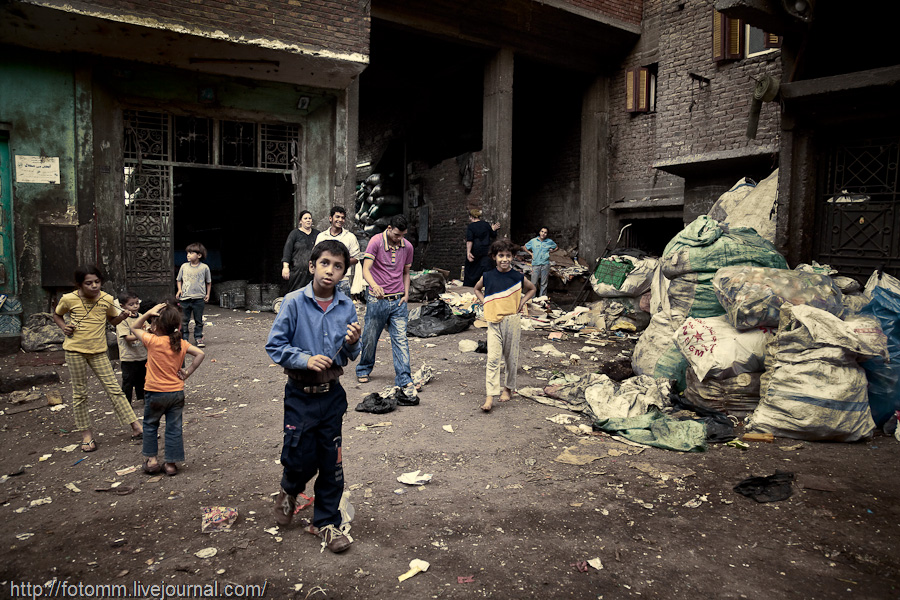


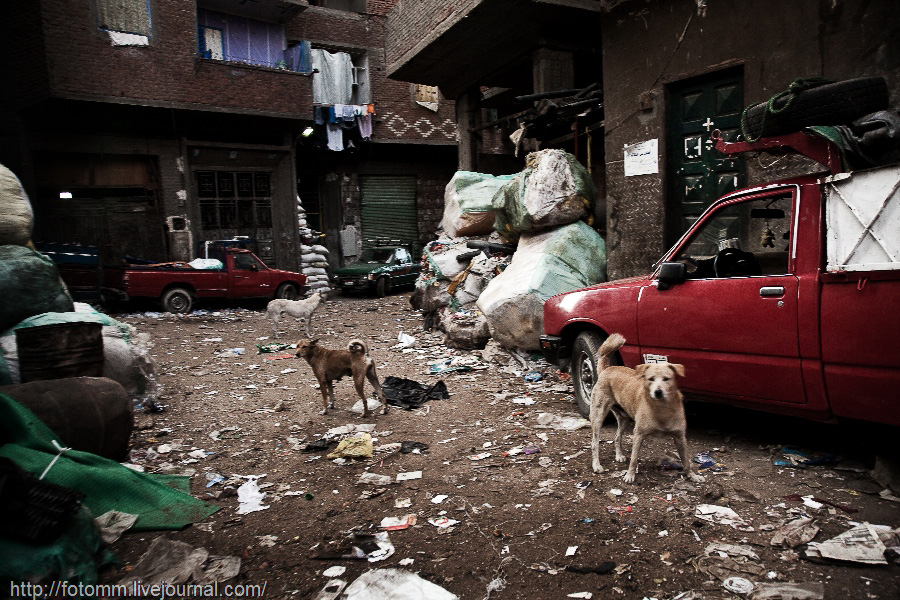







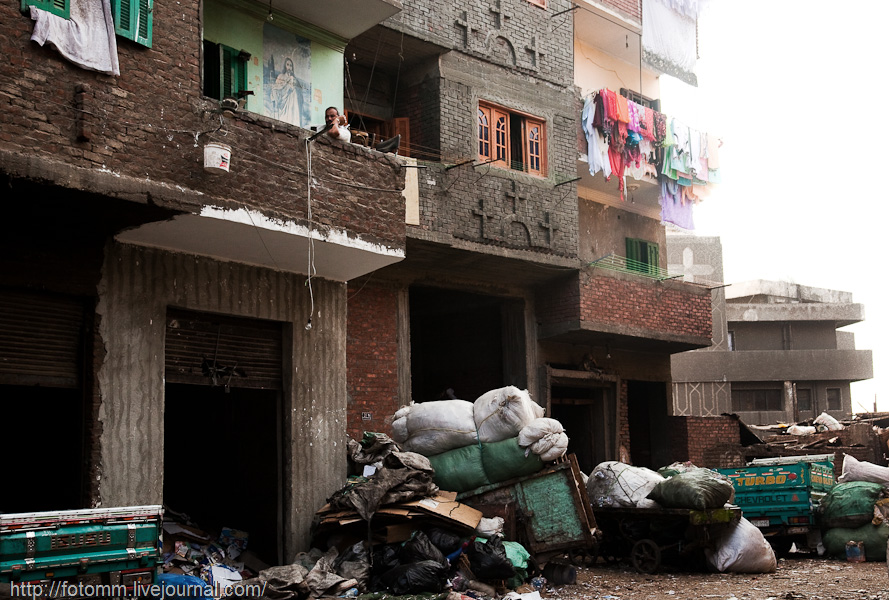




Children are among the mountains of garbage field for its fun ..

Drummer garbage work.

It looks like a horse mask (do not know how the horses and the people he needed as a second here!).
In fact - just a bag of feed for horses.


On the road to the yards precious cargo is delivered to young antediluvian truck or just on carts pulled by donkeys.


Photos too much for one post, so if you want to be - see the continuation in next time.
If you still have the desire to look at it:)
Actually I was going to send this material in any publication of a travelers' orientation, but has not decided where.
So a little messed up with the text, when rewriting under LJ, there inconsistencies between the text and pictures - I hope it's not too messed up stuff ..
--
You received this message because you are subscribed to the Google Groups "kl-bogel" group.
To post to this group, send email to kl-bogel@googlegroups.com
To subscribe or unsubscribe at http://groups.google.com.my/group/kl-bogel/subscribe
For more options, visit this group at http://groups.google.com/group/kl-bogel?hl=en
Sebarang email pertanyaan, hantar kepada abangmod@gmail.com

It is said that the city - a single organism.
Home with them, dwelling in his people-living cells. Electricity, water, sewerage - that without which would not exist these cells. Gardens and parks - the lungs of the city, the center is its heart. Roads, arteries of the city - supply and saturate his organs - quarters of the necessary materials.
The life of this living organism does not disappear for a second and during his life he had to get rid of toxins - litter and waste.
If we continue this analogy, the city scavengers, so call this a quarter of Cairo - the liver of old and sick body, which passes over the age of ten centuries.
Getting here is easy. In just half an hour you can reach the Citadel of Saladin, one of the most visited tourist sites in Cairo.
Already from the Citadel you make out on the immense panorama of the ten millionth metropolitan district with houses unusual red-violet color.
Another question - is it worth to go here at all and are you ready for what is here will see.
I decided on this, prompted by curiosity and passion for the photographer, although perfectly aware that coming here alone and at night can be dangerous. Reassured that at the end of a long journey to Egypt, my view has been far from the kind of glossy tourist with an expensive camera and I to some extent mimic the surrounding environment me.
I knew that somewhere out there in the mountains Mokattam, the Monastery of St. Simeon and the road to it just passes through the city scavengers, so after some deliberation, decided to visit those places.
Only appeared on the outskirts of the quarter, I saw this picture: teenagers gathered sounds from a tape recorder music, dancers, relieving each other out in the center of the circle and incendiary
http://www.youtube.com/watch?v=aITsbw3Xbwo
According to statistics from Cairo generates 6500 tonnes of waste per day, of which 3-3.5 thousand tons harvested zaballiny so called representatives of particular social group of about 40 thousand people living in the Medina district Zebela. For many years the only thing they are doing, handed down from generation to generation - collecting, sorting and recycling waste.
The area came in 1969 when the city administration decided to Cairo, all the garbage collectors to concentrate in one place.


Rubbish dump here brought huge that I saw standing on the road - there were about fifty, no less!
Hence, garbage bags in cars goes round the courtyards and smaller homes, where families have, from children to the elderly - all involved in its sorting.


Hanging from the balconies and roofs of piles of rubbish, bags of waste, blocking the already tight streets - this is the first thing that catches the eye when you get on this gloomy territory quarter.

Metal, paper and cardboard, rags and plastic - all packed into individual bags. What you then just burn, from which over the quarter is heavy with the smell of burning plastic, then taken away for recycling facilities.


Meanwhile on the streets is normal life. Children play and make noise, the men sitting primly and smoke hookah, immediately selling fruit and baked bread, on the first floor houses the usual food stalls and edalni. Apart from the people on the streets full of animals - goats and chickens that dogs, cats, as well as pigs, which also contribute their mite to the destruction of all possible waste.

A couple times I tried to look inside the homes, but the lower floors are generally so swamped with dense, break up that I could not.
Before you "dive" inside, I gained a deep breath, that even outside breathed with difficulty, not to mention the stench that prevails inside ..
The dim setting sun made its way through the barely small windows without glass and doorways without doors. In the darkness with hardly could be seen swarming among the waste of human figures. Some at the sight of the camera made prohibiting gestures, others continued to busily engaged in the business, not paying any attention to me.
Within a minute, I would jump out, so as not to suffocate ..



And nobody pays any attention to the huge bales That in some places already cover travel, hanging with all the balconies are on rooftops and in courtyards.
Add to this myriad of buzzing flies, dead rats and cats under their feet, and most importantly smell that accompanies all this, has developed a very real picture of the apocalypse.









Wandering the streets, littered with garbage, I think often come across images of Jesus, crosses, and other attributes of the Christian faith.
The main population of the quarter - the Copts, adherents of one of the branches of the Christian Church. Copts have become scavengers in the days of Caliph Al-Hakim. It was the ruler of the Fatimid dynasty, conquered Egypt. He ended a relatively peaceful life of all Christians, and Muslims living in the country. Copts in particular have lost everything. They were supposed to do the dirtiest and hard work. So the garbage and began their life.
Most of all I was impressed by hanging on the ropes, and as if hovering in the recesses between the houses, chapels, made of plywood and cardboard. They are plastered with pictures of the Creator, are decorated with crosses and electric lights.
The meaning of such structures is quite understandable - the holy faces of Jesus should not touch the dirt. And how to do it in a city that seems to be just out of it and is?



















Children are among the mountains of garbage field for its fun ..

Drummer garbage work.

It looks like a horse mask (do not know how the horses and the people he needed as a second here!).
In fact - just a bag of feed for horses.


On the road to the yards precious cargo is delivered to young antediluvian truck or just on carts pulled by donkeys.


Photos too much for one post, so if you want to be - see the continuation in next time.
If you still have the desire to look at it:)
Actually I was going to send this material in any publication of a travelers' orientation, but has not decided where.
So a little messed up with the text, when rewriting under LJ, there inconsistencies between the text and pictures - I hope it's not too messed up stuff ..
--
You received this message because you are subscribed to the Google Groups "kl-bogel" group.
To post to this group, send email to kl-bogel@googlegroups.com
To subscribe or unsubscribe at http://groups.google.com.my/group/kl-bogel/subscribe
For more options, visit this group at http://groups.google.com/group/kl-bogel?hl=en
Sebarang email pertanyaan, hantar kepada abangmod@gmail.com
Comments
Post a Comment